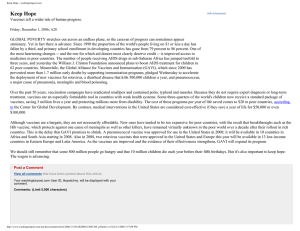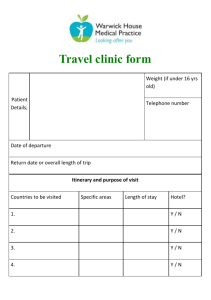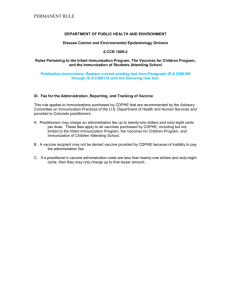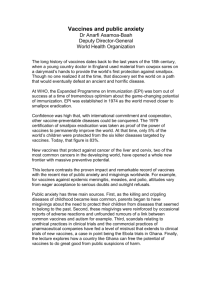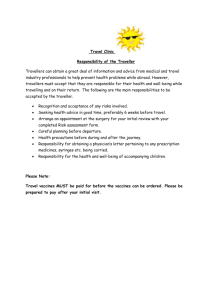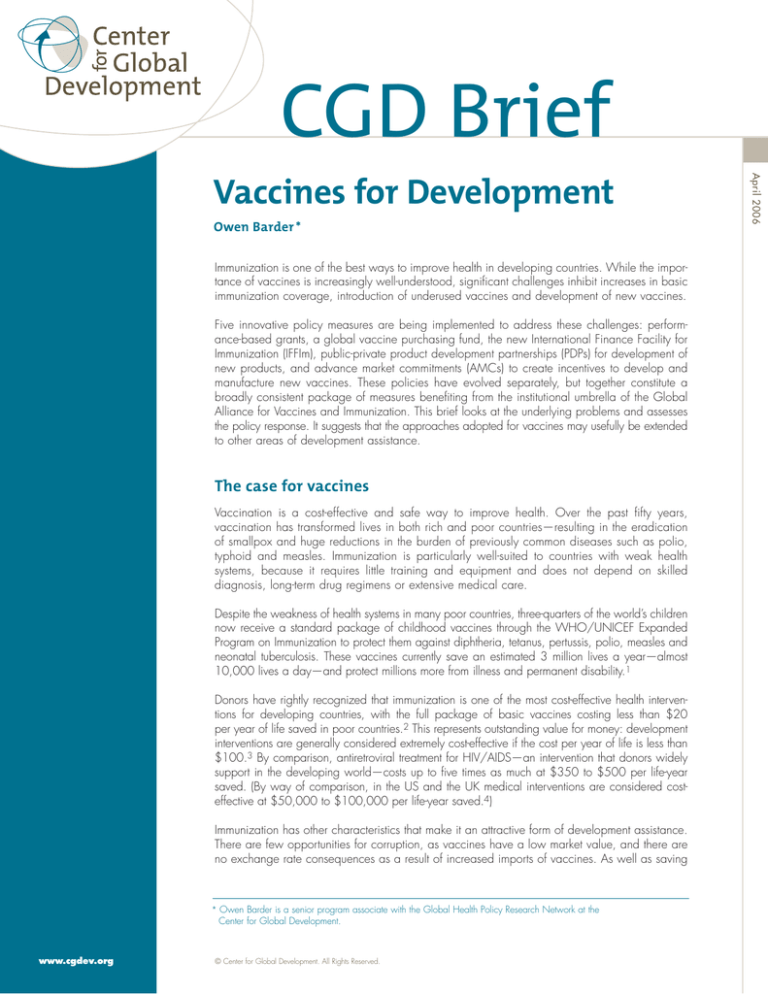
CGD Brief
Owen Barder *
Immunization is one of the best ways to improve health in developing countries. While the importance of vaccines is increasingly well-understood, significant challenges inhibit increases in basic
immunization coverage, introduction of underused vaccines and development of new vaccines.
Five innovative policy measures are being implemented to address these challenges: performance-based grants, a global vaccine purchasing fund, the new International Finance Facility for
Immunization (IFFIm), public-private product development partnerships (PDPs) for development of
new products, and advance market commitments (AMCs) to create incentives to develop and
manufacture new vaccines. These policies have evolved separately, but together constitute a
broadly consistent package of measures benefiting from the institutional umbrella of the Global
Alliance for Vaccines and Immunization. This brief looks at the underlying problems and assesses
the policy response. It suggests that the approaches adopted for vaccines may usefully be extended
to other areas of development assistance.
The case for vaccines
Vaccination is a cost-effective and safe way to improve health. Over the past fifty years,
vaccination has transformed lives in both rich and poor countries—resulting in the eradication
of smallpox and huge reductions in the burden of previously common diseases such as polio,
typhoid and measles. Immunization is particularly well-suited to countries with weak health
systems, because it requires little training and equipment and does not depend on skilled
diagnosis, long-term drug regimens or extensive medical care.
Despite the weakness of health systems in many poor countries, three-quarters of the world’s children
now receive a standard package of childhood vaccines through the WHO/UNICEF Expanded
Program on Immunization to protect them against diphtheria, tetanus, pertussis, polio, measles and
neonatal tuberculosis. These vaccines currently save an estimated 3 million lives a year—almost
10,000 lives a day—and protect millions more from illness and permanent disability.1
Donors have rightly recognized that immunization is one of the most cost-effective health interventions for developing countries, with the full package of basic vaccines costing less than $20
per year of life saved in poor countries.2 This represents outstanding value for money: development
interventions are generally considered extremely cost-effective if the cost per year of life is less than
$100.3 By comparison, antiretroviral treatment for HIV/AIDS—an intervention that donors widely
support in the developing world—costs up to five times as much at $350 to $500 per life-year
saved. (By way of comparison, in the US and the UK medical interventions are considered costeffective at $50,000 to $100,000 per life-year saved.4)
Immunization has other characteristics that make it an attractive form of development assistance.
There are few opportunities for corruption, as vaccines have a low market value, and there are
no exchange rate consequences as a result of increased imports of vaccines. As well as saving
* Owen Barder is a senior program associate with the Global Health Policy Research Network at the
Center for Global Development.
www.cgdev.org
© Center for Global Development. All Rights Reserved.
April 2006
Vaccines for Development
Vaccines for Development
2
lives and preventing suffering, there is a well-established virtuous circle linking improvements in health and life-expectancy
to the country’s long-term economic performance.5
Policy challenges in vaccination
Figure 1 below shows the annual deaths that could be
prevented by current or possible future vaccines.
Approximately 1.2 million people die needlessly each year
because they did not receive the basic six vaccines against
tuberculosis, diphtheria, neonatal tetanus, whooping cough,
polio and measles, all of which have been widely used in
rich countries since the early 1960s. At least a further 2-3
million deaths a year could be avoided by full use of underused vaccines against Haemophilus influenzae type B (Hib)
and hepatitis B as well as the introduction of new vaccines
against pneumococcal disease and rotavirus.
infrastructure, more and better trained personnel, and
improved information and logistics. While many countries
have demonstrated that vaccines can be delivered inexpensively to remote and rural areas, not all have had sufficient
resources or managerial capability to make the modest investments needed. Some donors are reluctant to pay for the recurring expenses of an immunization program, preferring more
visible interventions that make better headlines even though
they may not be as effective at saving lives.
Three main challenges hinder more widespread use of vaccines.
Second, some of the existing vaccines have not been
affordable for developing countries, so that even where
children can be vaccinated, governments could not afford
to buy the full package of childhood vaccines—particularly
the newer, more expensive vaccines. There is a vicious
circle of unpredictable and insufficient donor funding,
which leads to unpredictable and insufficient expressions of
demand from governments, which in turn reduces
investment in vaccine production, driving up unit costs and
contributing to supply shortages.
First, extending basic vaccine coverage in developing countries depends on building up the health systems with physical
More than a decade after the widespread introduction in the
U.S. and Europe of the Hib vaccine, which protects against
F i g u re 1 . The Vaccine Challenge
Size of bubble represents number of averted deaths per year.
HIV/AIDS
= 250,000 deaths averted per year
MALARIA
New
generation
vaccines HPV
TB
PNEUMO
ROTA
Underused
vaccines
FLU
Possible future
vaccines
JE
TYPHOID
HEP B
YF
CHOLERA
HI B
POLIO
MEASLES
TETANUS
Introduction
1960
Traditional
EPI Vaccines
1980
2000
2020
T h re e p o l i c y c h a l l e n g e s
■
■
■
Insufficient resources for health systems
High prices & unstable demand
Insufficient R&D for new vaccines
Uncertain
demand
Five policy innovations in vaccines
Limited
supply
Higher
price
sepsis, pneumonia, meningitis and ear infections, fewer than
ten percent of infants in the world’s poorest seventy-five countries were routinely receiving it as part of their childhood immunization package, which resulted in almost half a million
avertable deaths per year.
Third, there are insufficient commercial incentives for the
pharmaceutical industry to invest in R&D for diseases primarily affecting poor countries, such as malaria, tuberculosis,
HIV and other tropical diseases. In the past, vaccines developed against diseases afflicting rich countries, such as for
measles and polio, have been widely and effectively used in
developing countries. But there is no commercial rationale to
develop vaccines for diseases that occur mainly in the poorest countries and for which there would be only a very small
market in rich countries. Though these diseases kill millions of
people, the communities affected cannot afford to buy vaccines at a price that would enable developers to recover the
research and development costs.
As a result of these three policy challenges, many children
remain completely unvaccinated despite the safety, efficacy
and affordability of immunization; many others do not
receive the full package of available life-saving vaccines;
and pharmaceutical innovation is not being extended to the
diseases most affecting the poorest countries.
Five important and related innovations have been designed to
meet these challenges and maximize aid effectiveness, largely
under the purview of the Global Alliance for Vaccines and
Immunization (GAVI). GAVI is a public-private partnership that
was formed in 1999 to bring together governments, established and emerging vaccine manufacturers, nongovernmental
organizations, research institutes, UNICEF, the World Health
Organization, the Bill & Melinda Gates Foundation and the
World Bank with the goal of strengthening national health and
immunization systems, introducing new and underused vaccines, and accelerating the development of new vaccine.
PERFORMANCE-BASED GRANTS
From the outset, GAVI adopted a new financing mechanism to
build health and immunization infrastructure in developing
countries by increasing country ownership and linking funds to
both need and performance. Funds are allocated based on
country-defined need, with countries with lower immunization
rates and high numbers of unvaccinated children getting more
resources. Countries with immunization rates of less than 80%
can apply for funding to build their health capacity and
improve immunization services and can decide themselves
how best to use those funds to increase immunization rates.
After an initial investment phase, future awards are dependent
on the countries meeting their goals and showing results,
backed up by data quality audits. The early signs are that linking
funding to outputs in this way has successfully created incentives
for improved performance, while providing assurance for
donors that funds are used for the purposes intended.
PURCHASING FUNDS & POOLED PROCUREMENT
An equally important innovation behind the creation of GAVI
was the establishment of a purchasing fund for new and underused vaccines against yellow fever, hepatitis B and Hib, particularly combined with the existing diphtheria-tetanus-pertussis
vaccine to facilitate rapid uptake and integration into routine
immunization schedules. This enabled countries to obtain
vaccines that they couldn’t have otherwise afforded, and by
drastically increasing available resources for these products
3
April 2006
F i g u re 2 . The vicious circle of uncertainty,
supply and cost
Vaccines for Development
4
and pooling their procurement through UNICEF, GAVI demonstrated a more reliable demand and attracted several new
vaccine manufacturers to enter the under-supplied market.
However, the expansion of demand for vaccines without corresponding improvements in procurement practice (such as the
ability to enter into binding long-term contracts) has resulted in
price increases for some vaccines. As a result of these increases and uncertainties about long-term donor financing, the introduction and uptake of newer vaccines in developing countries
has been slower than anticipated. GAVI needs to develop reliable and fair burden-sharing among donors, create a predictable and sustainable long-term financing framework for
developing countries to enable them to invest in the introduction of new vaccines, and establish long-term procurement
contracts with vaccine suppliers that would lower prices and
increase security of supply by reducing risk.
THE INTERNATIONAL FINANCE FACILITY
FOR IMMUNIZATION
IFFIm is a new financing mechanism that will increase the
resources available for childhood vaccines in poor countries.
Donors will make long term pledges of funding, on the basis of
which GAVI can borrow money from financial markets in order
to front-load spending on vaccination programs and to enter
into long-term procurement contracts. The aim is that both developing countries and vaccine manufacturers will be able to plan
ahead, in the knowledge that the necessary resources will be
available. This is expected to secure lower prices, accelerate
increased availability of new vaccines, and support the substantial system improvements required to absorb new vaccines.
The goal is to scale up coverage to 90% in every country.
IFFIm aimed to secure commitments of at least $4 billion, which
is estimated to prevent 5 million child deaths between 20052015 and more than 5 million future adult deaths. By April
2006, commitments to IFFIm had been made by Brazil, France,
Italy, Norway, Spain, Sweden, South Africa and the UK.
The UK Government has advocated the idea that spending
on international poverty reduction could be more effective if
it were “front loaded” rather than spent over time as aid
budgets allow.6 The proposal for an International Finance
Facility suggests that the gains from bringing spending
forward exceed the borrowing costs. Recent work by the
Center for Global Development shows that this is most
certainly true for vaccinations, regardless of whether it is true
for aid spending more generally.7
Front-loading spending on vaccination increases the cost-effectiveness of spending for three reasons. First, there are long term
herd-immunity benefits from vaccination. By increasing immunization coverage rates today, the disease level falls and the
risk of catching the
disease is reduced
By front loading spending
in the future. This
means that an
on vaccines and making
immunization today
funding more predictable,
is worth more than
the IFFIm will hugely
an immunization
tomorrow. Second,
increase value for
the commitment of
money and so save
funds to IFFIm
should enable purmany more lives.
chasers to enter into
long term contracts
with vaccine suppliers, which in turn would allow producers to
build larger plants and achieve significant returns to scale. This
can reduce the costs of vaccination very substantially. Third, the
long term commitment enables proper planning and sequencing of investment in systems, training and purchasing to
strengthen immunization systems, delivering greater value for
money than spending money on a year-to-year basis.
The argument for IFFIm rests on whether these benefits are large
enough to outweigh the interest and financing costs. We find
that even after taking the financing costs into account, frontloading spending on vaccines as envisaged by IFFIm increases value for money by 22 percent.8 Of that, about half of the
benefit is the result of front-loading the spending, and half is
impact of greater predictability that the mechanism permits.
GAVI intends to use IFFIm resources to complement its other
activities, although it has yet to capitalize on the mechanism’s
predictability by enabling purchasers to enter into long term
purchasing arrangements.
PRODUCT DEVELOPMENT PARTNERSHIPS
Over the last decade, dozens of partnerships have been
developed to link global health organizations, pharmaceutical
manufacturers, biotech firms, academia, and developingworld governments. These public-private partnerships have
diverse objectives, composition, organizational structures and
funding. Some support the distribution and use of existing
medicines, while others focus on beginning or completing the
development of new medicines.
The partnerships which aim to develop new vaccines and
drugs are known as product development partnerships (PDPs).
They typically use a portfolio management approach by
investing in different companies who then undertake the
research. Examples from the vaccine world include the
International AIDS Vaccine Initiative (IAVI), the Malaria
Vaccine Initiative (MVI), and the Meningococcal A/C partnership at PATH.9 Another non-profit business, Institute for
As well as product development PPPs, there are other initiatives
(including GAVI’s Accelerated Development and Introduction
Plans for rotavirus and pneumococcus, as well as the new Hib
Initiative), which are focused not only on development of new
vaccines but also on promoting the rapid introduction and use
of new vaccines by informing evidence-based decision-making
within national Ministries of Health.
The advance market commitment proposal therefore tackles two
of the main policy challenges: lack of affordable access to
vaccines that have been developed, and insufficient commercial
incentive to develop vaccines for diseases concentrated in
developing countries. The G8 Finance Ministers have endorsed
the concept, and have called for further technical work to
enable them to launch an advance market commitment.
ADVANCE MARKET COMMITMENTS
An advance market commitment is an incentive to stimulate
the commercial development and rapid introduction of new
vaccines. Donors would make a legally binding guarantee
that, if a future vaccine is developed against a particular disease, they will pay for it to be bought by developing countries. The guarantee would be linked to technical standards
that the vaccine must meet, and be structured in a way to
allow several firms to compete to develop and produce the
best possible new vaccines.10
MOVING FORWARD
Vaccines are increasingly recognized as having an essential
role to play in improving public health and promoting
development in poor countries. They are a cheap, effective
and safe way to combat infectious diseases and so improve
the lives and livelihoods of the poor. Vaccines are a necessary
component of any strategy to meet the Millennium
Development Goals.
These partnerships are useful for development of new vaccines. They coordinate industry, academic partners and contractors along the vaccine development pipeline, and they
manage development portfolios, including in some cases the
selection and termination of projects based on the progress
they are making.
A Center for Global Development Working Group examined
this proposal in detail, and established that a commitment
large enough to have a significant impact on the incentives
of the pharmaceutical companies would still represent an
excellent value for money. A donor commitment to buy vaccines that would offer firms revenues broadly similar to those
they earn from drugs they have developed for rich country
markets could immunize children at a cost of $15–$30 per
life-year saved. This would be highly cost-effective by comparison with other development interventions.
This approach has a number of attractive features. It enables governments to fund the development of new vaccines without hav-
Greater use of vaccines is, however, inhibited by three constraints: insufficient resources to develop health systems; the cost
of new vaccines, partly as a result of unpredictable demand;
and the lack of commercial incentive to develop new vaccines
for diseases concentrated in developing countries.
Figure 3 illustrates how the five policy innovations address these
challenges. Though the policies have been developed separately, they contain the makings of a coherent response to the
need to increase access to vaccination in developing countries.
Through its performance-based grants and vaccine purchasing
fund, GAVI channels additional resources to enable health
systems development and to increase resources for vaccine
procurement. With the addition of the International Finance
5
April 2006
The PDPs tackle an important policy challenge, namely the lack
of investment in new vaccines for diseases which mainly affect
poor countries. However, even with generous funding—the
vast majority of which comes from the Bill & Melinda Gates
Foundation—the total investment in research for vaccines into
these diseases is small relative to medical R&D for diseases of
rich countries, and tiny relative to the health burden that these
diseases impose.
ing to select particular scientific opportuAdvance market
nities to support; and
if no vaccine is
commitments both
successfully develaccelerate the
oped there is no cost
development of new
to the taxpayer. For
firms, it offers the
vaccines, and ensure
opportunity to make
that they are available
commercial returns in
at an affordable price
new markets which
at present do not
when they have been
offer substantial
developed.
returns. And for
developing countries,
it increases the
prospects not only of accelerated development of new vaccines,
but also provides funding to ensure that those vaccines will be
affordable once they have been developed.
OneWorld Health, uses intellectual property donated by companies to investigate how those technologies can be used to
improve global health.
F i g u r e 3 . Challenges and Policies
Vaccines for Development
6
Insufficient
resources
to buy vaccines
GRANTS
FUND
PDPS
IFFIM
AMCS
High prices &
unstable demand
Insufficient R&D
on new vaccines
Facility for Immunization, GAVI should make longer term
commitments through UNICEF, which together with
front-loaded spending will make purchasing more predictable
and bring down vaccine prices, as well as enabling better
planned investment in health systems. The public private
partnerships have increased resources flowing to the
development of vital new vaccines, and helped countries to
position themselves to take advantage of the opportunities
that these provide. Finally, if advance market commitments
are implemented, they will complement that increased
research with commercially financed research and will help
to ensure that new vaccines are widely available when they
are developed.
Within this broad framework of immunization challenges
and opportunities for innovation, policy makers within
donor governments, technical agencies, pharmaceutical
companies and national Ministries of Health will face many
choices about how to best increase immunization over the
coming years. As they do, they should be guided by the following principles:
Retain a strategic overview of the challenges, and take a
coherent view of the way in which these approaches can
work together to meet them.
Ensure that the funding for the purchase of vaccines is
consistent & predictable, to enable developing countries
to introduce new vaccines with confidence about long
term sustainability. IFFIm represents one such mechanism,
national budgetary processes permitting.
Reform the procurement of vaccines by entering into
long-term contracts, so that vaccine companies can
invest in expanded production to bring down costs by
reducing risk burden.
Increase investment in health systems in developing
countries to ensure that immunization reaches as many children as possible.
Send consistent signals that the goal of policy is not
merely to buy vaccines as cheaply as possible, but also
to ensure that vaccine companies can make reasonable
returns producing vaccines to meet global demand and
to enable them to develop new vaccines.
Increase funding for all these approaches together
and ensure that additional resources for the development of
vitally needed new vaccines are not competing with funding available for the purchase and use of existing products.
7
1 Owen Barder, Michael Kremer, and Heidi Williams (2006) “Advance Market Commitments: A Policy to Stimulate Investment in Vaccines
for Neglected Diseases,” The Economists’ Voice: Vol. 3: No. 3, Article 1. http://www.bepress.com/ev/vol3/iss3/art1. pg. 398.
2 Ramanan Laxminarayan, Jeffrey Chow, and Sonbol A. Shahid-Salles (2006). “Inptervention Cost-Effectiveness: Overview of Main
Messages. Disease Control Priorities in Developing Countries. 2nd ed. (Washington, DC: World Bank, 2006). p. 44.
3 Throughout this brief, “life-years” and “year of life” consistently refer to disability-adjusted life-years (DALYs).
4 Owen Barder & Ethan Yeh The costs and benefits of front-loading and predictability of immunization, CGD Working Paper 80.
(Washington, DC: Center for Global Development, 2006). http://www.cgdev.org/content/publications/detail/6178.
5 Peter Lorentzen, John McMillan, and Romain Wacziarg. “Death and Development,” National Bureau of Economic Research Working
Paper 11620. http://www.nber.org/papers/w11620.
6 H M Treasury and DFID, The International Finance Facility, September 2005
http://www.hm-treasury.gov.uk/media/837/60/IFF_proposal_Sep_05.pdf.
7 Owen Barder & Ethan Yeh (2006) op cit.
8 Owen Barder & Ethan Yeh (2006) op cit.
9 William Muraskin (2002) “The last years of the CVI and the birth of the GAVI.” In Public-private partnerships for public health.
Edited by M Reich. Cambridge, Massachusetts; Harvard Center for Population and Development Studies; 2002:115-68.
10 Owen Barder, Michael Kremer, Ruth Levine and the Advanced Market Commitment Working Group (2005) Making Markets for
Vaccines, Washington, DC: Center for Global Development.
About the Global Health Policy Research Network
The Global Health Policy Research Network (GHPRN) brings together leading experts in public health, economics and other social
science and technical fields to develop original, focused research on high-priority global health policy issues. The GHPRN seeks to
improve the outcomes of donor decision-making in global health by:
■
■
■
Providing a rich evidence-base about policy opportunities and constraints to effective public and private aid in the health sector;
Bringing new people and perspectives—both multidisciplinary and global—into health policy analysis to increase the robustness of
the debate; and
Supporting the development of innovative solutions to global health financing and other policy problems.
The GHPRN seeks opportunities to contribute analyses about better ways to stimulate and support innovation in products, effective
public health practices and delivery strategies; to ensure equitable access over the long-term to key health services; and to better
understand how investments in the health sector effects both health conditions and broader economic and social development.
In addition to Advance Market Commitments, other GHPRN Working Groups have explored:
■
■
■
■
■
■
How to identify examples of ‘what works?’ in global health and the factors that contribute to those successes;
How to build a comprehensive, credible base of information about financial flows to global health, which is responsive to advocacy,
program and policy data needs;
How to stimulate development agencies to conduct rigorous impact evaluations of major development projects, so that they contribute
to global knowledge about what works;
How to measure a government’s commitment to health;
How to effectively harness performance-based incentives in health;
How to increase access to pharmaceutical products through better demand forecasting;
The Center for Global Development leads the GHPRN with support from the Bill & Melinda Gates Foundation. For more information
on CGD’s Global Health Policy Research Network, please visit www.cgdev.org/globalhealth
April 2006
References
The
Center for Global Development is an independent, non-partisan, non-profit think tank
dedicated to reducing global poverty and inequality through policy oriented research and active
engagement on development issues with the policy community and the public. A principal focus of
the Center’s work is the policies of the United States and other industrialized countries that affect
development prospects in poor countries. The Center’s
research assesses the impact on poor people
of globalization and of the policies of governments and multilateral institutions. In collaboration with civil
society groups, the Center seeks to identify
policy alternatives that will promote equitable growth
and participatory development in low-income and transitional economies. The Center works with other
institutions to improve
public understanding in industrialized countries of the economic, political,
and strategic benefits of promoting improved living standards and governance in developing countries.
1776 Massachusetts Ave., NW
Third Floor
Washington, D.C. 20036
w w w. c g d e v. o r g
CGD Brief
Vaccines for Development
Owen Barder
April 2006

